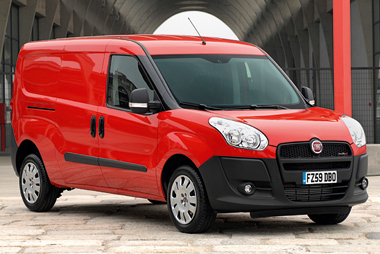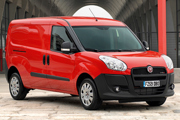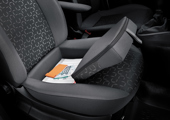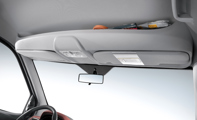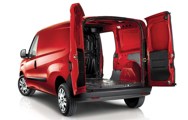Review
We commercial vehicle journalists are not supposed to have favourites. Our job is to sit on the fence, assess each vehicle on its merits and offer you, the great van-buying public, advice on which models are best.
But I have to admit here and now that the Fiat Doblo Cargo has been one of my particular favourites in the small van sector since its launch back in 2000.
True it’s never really set the sales charts on fire and some people think it’s ugly, but I’ve always admired Fiat for daring to be a little different from the others and producing a funky looking vehicle with a wacky interior and a dash that’s all curves and swirls. On top of that it had a lusty diesel powerplant and road manners that were arguably class-leading at the time.
But take a look at the pictures of the new Doblo Cargo and you’ll hardly believe it’s the same vehicle. Funky has given way to chunky – and right from clapping eyes on this van for the first time at the international launch in Turin, I could tell that Doblo Mk II is going to be a very different kettle of fish from its predecessor in terms of fleet success.
You could be forgiven for thinking that this vehicle bears little resemblance to the old model – in fact, apart from the name only the brake calipers and fuel lines are carried over. Everything else, including a new set of Euro V compliant diesel engines, is new.
The new Doblo Cargo is launched into the closest-fought of any of the LCV sectors at present. We have the Citroën Berlingo, which recently won the Fleet Van ‘Van of the Year’ title for the second year running, its twin brother the Peugeot Partner, the Volkswagen Caddy, the Ford Transit Connect, the Renault Kangoo and – just launched in January – is the new Nissan NV200.
So what can the new Doblo Cargo bring to the fleet market?
You only have to look at the pictures here to see that it has grown considerably in size and the Doblo Cargo now boasts the biggest payload of any van in the sector – up to one tonne – along with load capacity of up to 4.2 cubic metres and a string of best-in-class features such as service intervals, CO2 emissions and running costs.
And Fiat has also made great strides in fleet in the past year or so. There are now 60 Fiat Professional dealers in the UK offering expert advice, longer opening hours and replacement vehicles – in fact, Fiat’s fleet story has been so notable that it was given a special prize at the recent Feet Van awards for ‘Most Improved Van Manufacturer’.
Fiat has spent 450 million euros developing the new Doblo Cargo and when it hits the UK this month, it will be offered with long and short wheelbases, standard and high roofs, van and chassis-cab versions and an array of both Euro IV and Euro V compliant engines, both petrol and diesel.
There will also be five and seven-seat car versions and in Europe, a CNG-powered variant.
Built in Turkey on the Fiat Punto platform, the new Doblo Cargo will have a total of 400 different versions altogether. Fiat sold 800 Doblo Cargos in the UK in 2009 and hopes to boost that figure to 2,000 per year with this new model.
Outside, the new Doblo looks more solid and robust than its predecessor and can now carry more than the old Scudo model which was in the segment above. Inside, loads of up to 3.4 metres in length can be carried, while there is room for two Euro pallets. Volumes go up to 4.2 cubic metres for the long wheelbase version with a special fold-down passenger seat. Payloads, meanwhile, range from 750kg to 1,000kg, the first van in this sector to carry one tonne.
In the front, the cab is more traditional than in the old model and features lots of goodies for the driver, including an overhead parcel shelf and side door pockets that hold A4 documents and two half-litre drink bottles. The glovebox will hold a 14-inch laptop and there is a clever hinged portion in the passenger seat that lifts up to reveal a secret document space.
There is also a document clip on the dashboard for holding delivery notes and suchlike.
On the safety front, ABS brakes and EBD are standard but ESP stability control is a paid-for option. The Ford Transit Connect is the only van in this sector to have this life-saving gadget as standard.
There are also front and side airbags and a hill-holder.
Technology bristles in this van too. A TomTom Blue&Me system will be available as an extra, which acts as an infotainment system which manages a mobile phone, MP3 player, navigation system and all driving information.
Also available is an Ecodrive software system which monitors driving styles – a useful extra for fleet managers.
Under the bonnet there is a huge range of engines. Firstly, a 1.4-litre petrol engine offering 90bhp at 6,000rpm and 94lb-ft of torque at 4,500rpm, and 1.3, 1.6 and 2.0-litre Multijet diesels offering between 90bhp and 135bhp and torque of between 147lb-ft and 236lb-ft.
Fuel economy ranges from 40.35mpg to 58.8mpg and CO2 figures go from 126g/km to 163g/km.
All Euro V engines will feature Fiat’s Start&Stop system as standard. This cuts out the engine after it has been idling for two seconds and automatically restarts it when the driver dabs the clutch.
Euro IV engines have a five-speed gearbox while Euro V versions have six cogs. During the coming year there will also be a ‘robotised’ semi-automatic version on offer.
UK prices range from £11,195 to £16,945 ex-VAT.
Behind the wheel
It was Fiat’s chief designer Peter Janssen who summed up the new Doblo car and Cargo van to a T at the launch in Turin. He said the new model was a car, a van, an MPV and an SUV all rolled into one. And he’s right.
Clap eyes on the Doblo for the first time and you could be forgiven for thinking it was a chunky off-roader.
It looks immensely strong and powerful compared to the old model and I immediately took to these new muscular lines.
Mind you, while the smaller Fiorino has plenty of plastic round the corners, there isn’t a lot here, which means that careless drivers could soon end up adding a whole pile of knocks and scrapes. It’s a point I raised with the Fiat executives at the launch and it is one that they are apparently looking into – so expect some kind of addition with a year.
As mentioned before, I rather liked the wacky swirls and curves of the cab in the old model but the designers have swung completely round this time and have opted for a sombre dash and interior with classic lines and a practical feel.
There is more legroom than in the rival Berlingo/Partner but Fiat doesn’t offer the option of a second passenger seat as do those rivals.
But there is no shortage of cubby holes and I particularly liked its lift-up compartment in the seat that can be used to hide items from prying eyes. I wonder how long it will be before thieves get to know about this?
The driver’s seat is among best in class. It’s quite hard but curves round the back and proved tremendously supportive on our test drive.
The rear end features twin sliding side doors and asymmetric rear ones and there is a handy wipe clean plastic floor inside. The Doblo also has six load-lashing eyes in place of the old four and fleets can opt for a swivelling cage bulkhead together with a special passenger seat that folds right down into the floor so that longer length cargoes can be carried.
Our test drive was in the long wheelbase Doblo Cargo with a 1.6-litre Euro V Multijet engine offering 105bhp. Fiat had added a 500kg cargo in the rear just to give us the impression of this van in the real world. And what a cracking drive it turned out to be.
Fiat boasted that its new door handles are so smooth that they can be opened with two fingers.
The same applies to the gearchange, while the steering gives plenty of feel for what’s going on down under.
If ride and handling aren’t best in class then they aren’t far off. The engineers at Fiat deserve a huge pat on the back for their efforts in giving this van remarkable composure.
With a half-load on board, it didn’t struggle, even during the mountain roads part of our drive, so for fleet purposes I can’t see that the 135bhp version is worth even looking at.
I’d be tempted to advise fleets not to bother with the Euro IV engines but it must be pointed out that these versions will be around £800 cheaper, so cash-strapped firms couldn’t be blamed for opting for the older technology.
All drivers won’t like the standard stop/start system that comes with Euro V engines. I found it a tad strange at first but the engine fires up quickly and quietly and I soon got used to it. As that system could save fleets up to 15% in fuel, it’s worth considering.
It’s a pity that Fiat has made ESP stability control a paid-for option. It’s standard on the Doblo car after all.
The only van in this class to have ESP as standard at present is the Ford Transit Connect. Had Fiat followed suit I’d conclude that the Doblo Cargo was a definite leader of the pack.
Specification
Gross vehicle weight (kg) 1,990-2,410
Power (bhp/rpm) 90/4,000-135/3,500
Torque (lb-ft/rpm) 94/4,500-236/1,500
Load volume (cu m) 3.4-4.2
Payload (kg) 750-1,000
Comb fuel economy (mpg) 40.35-58.8
CO2 emissions (g/km) 126-163
Prices (ex-VAT) £11,195-£16,945
Verdict
The new Doblo Cargo is such a quantum leap forward over the old model that I’m tempted to immediately vote it new leader of the sector. Lack of standard ESP may put the equally chunky Transit Connect above it, however.



